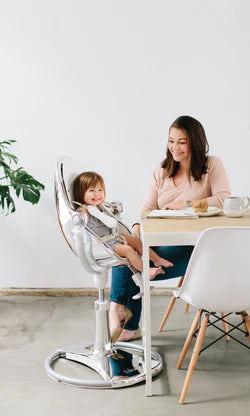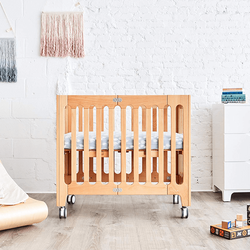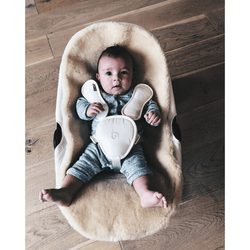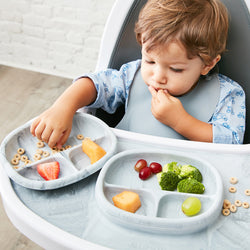
Baby's finally here. Now what? Turns out, they need a little time to develop before they can really take in the world, play, and interact (as much as you'd like them to do so from day 1). So what can you really do with an infant in those early stages? Turns out, quite a bit.
Marianne Rho, founder of occupational therapy clinic Connect the Dots, has a few ideas. She's broken down activities and games based upon age...because as most of us have come to realize, a 2-month-old is VERY different from a 9-month-old. The New York-based pediatric occupational therapist reveals appropriate interactions for each age range, from 0 to 12 months below.
So pop baby in his/her bouncer so they have proper support and can see you easily and settle in for a play session.
0-3 months
As newborns, babies start by typically seeing within 8-10 inches from their face and responds to high contrast objects (mainly black and white). Therefore in this stage the bouncer should be within a foot from what you'd like baby to see (i.e., toys, family members, etc.) It is important for the baby to be engaged in all visual fields to continue to entice them to move their eyes and their necks in all directions, as well as to change the location of the bouncer so that babies don't essentially get "stuck" in just looking at mom/dad always toward one side.
When sitting in the bouncer at this age, human interaction is the best! Talk, sing, and read with your babies...it's never too early to read to them! Start to engage them with small rattles as they will start to grasp them toward the end of 3 months. Of course tons of activities to do outside of the bouncer, including tummy time as the number one priority!
RELATED: 6 modern mobiles (that look great with our cribs)
4-6 months
You can start to hang toys from a toy bar around 3-4 months. Toward the 6-month range, as their fine motor skills are rapidly improving, babies will want to manipulate toys, rather than bat at them.
At 6 months infants begin to get mobile and responsive to surroundings and are able to see most colors and details in their environment. Games of interest at this stage include bubbles, peekaboo, transferring objects between hands (i.e., a ball), and using board books (storytime!). When in a supported chair (i.e., a highchair) or the Coco Go in the upright stationary seat mode, you can challenge their visual motor skills with simple rolling of balls and cause-and-effect toys. This is also a great age to introduce sign language, as babies are capable of imitating already!
RELATED: 7 essential travel tips for new parents
6-9 months
Our babies are now moving around and navigating their environment! Babies in this age are crawling, sitting up independently, and starting to cruise on furniture and really building those leg muscles. They can also pick up small objects using pincer grasp (taking things between their thumb and forefinger). Hide-and-seek and musical toys and instruments can enhance the child's hand control.
9-12 months
At this stage, babies are using the pointing gesture to communicate their interests and desires. They will also begin to proactively engage in their surroundings. They'll use their hands to grab small objects and eat finger foods, mainly through pincer grasping.
Finger play songs are great at this age, such as Itsy Bitsy Spider, and bubbles are always a hit as well. Row, Row, Row Your Boat type activities work well, where mom and baby are facing each other, holding hands, and "rowing" back and forth.
RELATED: new mom haze: "the moment i finally felt like me again"
If you're on the hunt for a bouncer, there are a few options. Our iconic Coco Stylewood is chic enough to sit in any room in the house, or our versatile Coco Go offers three modes, a vibration unit, and folds flat for easy travel and storage. If they're not already on your registry, add them now!
bloom coco go 3-in-1 lounger, rocker, babyseat from bloom on Vimeo.







